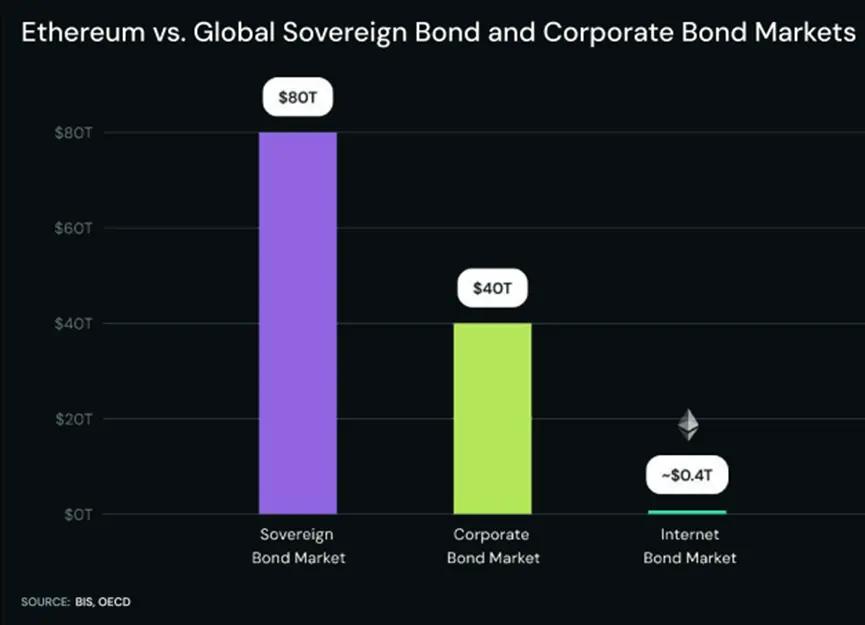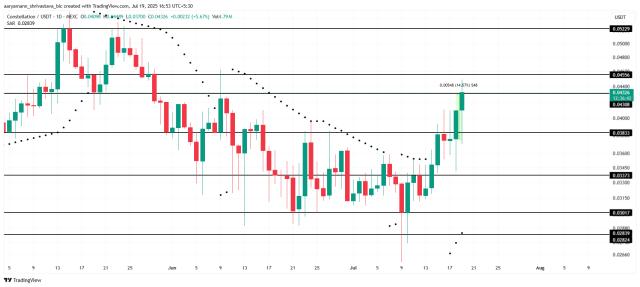Author: Obol Collective
Translated by: Felix, PANews
Key Points:
- Ethereum is entering a new decade and a brand new era. As the world's most secure and decentralized programmable blockchain, it has become the platform of choice for institutions. Just as Bitcoin won the status of "digital gold", Ethereum's native asset is gaining recognition as "scarce digital oil".
- Institutions are racing to accumulate ETH as part of their long-term strategic reserves, with over 1.7 million ETH added to "strategic ETH reserves" by 2025. As these institutions increase their ETH holdings, it has become the first interest-bearing digital commodity.
- ETH can be viewed as an internet bond, with staking providing institutions a risk-free way to accumulate returns. As Ethereum's adoption increases, ETH becomes increasingly scarce, and institutions will turn their attention to staking and distributed validators due to their security advantages.
- Institutions recognize that Ethereum will drive the development of the global on-chain economy. This is one of the main catalysts for Ethereum's future as a trillion-dollar network.
The Institutional Era of Ethereum Has Arrived
Institutions are embracing Ethereum. As major Wall Street players discover the potential of innovations like stablecoins, DeFi, and RWA, Ethereum is becoming their preferred decentralized platform. Institutions like BlackRock, JPMorgan, and UBS are building on Ethereum because it dominates these vertical sectors while maintaining significant decentralization and security advantages.
ETH is also gradually becoming a reserve asset. In recent years, several large enterprises have incorporated BTC into their reserve assets. Recently, a wave of publicly listed companies, DAOs, and crypto-native foundations have begun accumulating ETH as a long-term holding. Today, over 1.7 million ETH (valued at $5.9 billion) are locked in reserve assets, with total reserves doubling year-on-year.
Ethereum is the next global financial layer. Institutional investors are reserving ETH because they recognize it as the monetary foundation of this layer. ETH is the first digital asset that simultaneously possesses reliable neutrality, scarcity, utility, and yield. While BTC is recognized as the first reserve asset in cryptocurrency, ETH is the first interest-bearing reserve asset.
This report will focus on the first institutions adopting ETH as a strategic reserve asset. It will also look forward to how these institutions will stake ETH next, the role of distributed validators in establishing institutional staking standards, and why the race to adopt ETH as a reserve asset will be a catalyst for Ethereum's trillion-dollar valuation.
1. Why Institutions Prefer "Digital Oil" Over "Digital Gold"
Bitcoin undoubtedly became the world's first digital gold. Bitcoin is a non-sovereign store of value with unique attributes that are attractive to institutions. However, Ethereum is a more dynamic asset because it drives the global on-chain economy. As the world moves on-chain, Ethereum's utility and scarcity will increase simultaneously. If Bitcoin is digital gold, then Ethereum is digital oil.
[Image]
Institutions are expected to continue preferring digital oil over digital gold in the coming decade for three reasons:
1. BTC is idle, ETH is constructive. Bitcoin succeeded by acting as a passive value storage tool. In contrast, Ethereum succeeds by maintaining high efficiency. Ethereum is the essential fuel for the world's most decentralized and secure smart contract blockchain. Every operation in Ethereum's vast decentralized finance ecosystem, every NFT minting, and every Layer 2 network settlement requires ETH for transaction fees. Since EIP-1559 launched in August 2021, Ethereum has burned approximately 4.6 million ETH, worth about $15.6 billion at current prices, demonstrating its role as digital oil in the on-chain economy. Today, Ethereum secures approximately $237 billion in value across L1 and top L2 networks, and demand for ETH will continue to grow as the global economy moves more on-chain. Ethereum holds 57% market share in RWA and 54.2% of total stablecoin supply. In short, Ethereum leads in multiple metrics, and ETH is the driving force of its ecosystem.
2. BTC tends to be inflationary, ETH is becoming deflationary. BTC's supply plan is fixed, with a current issuance rate of about 0.85% that will programmatically decrease over time. As block rewards halve every four years, miners will increasingly rely on transaction fees. Some argue BTC's security budget is a potential threat. Ethereum adopts a different monetary policy directly linked to economic activity. ETH's total issuance is capped at 1.51% to incentivize network security, but since about 80% of transaction fees are burned through EIP-1559, the net issuance rate has averaged only 0.1% annually since the merge. ETH often experiences net deflation, and total supply (currently slightly below 120 million ETH) is expected to decrease as demand for Ethereum block space grows. In other words, ETH becomes scarcer as Ethereum becomes more widespread.
3. BTC generates no yield, ETH is a yield-generating asset. Bitcoin itself generates no returns. But ETH is a high-yield digital commodity. ETH stakers can lock Ethereum as validators and currently earn about 2.1% actual yield (nominal yield - new issuance). Stakers receive ETH issuance and part of transaction fees (the non-burned portion) with no counterparty risk, incentivizing long-term holding and active network participation. ETH differs from all other major crypto assets in that validator returns increase as Ethereum's economic throughput expands.
ETH as a Global Leading Reserve Asset
ETH becomes a global leading reserve asset because of its unique attributes. ETH satisfies three core requirements in a way no other asset can:
Pure settlement collateral. As the new economy continues to be built on tokenized assets bearing issuer and jurisdictional risks, the financial system needs a trustworthy neutral, non-sovereign collateral asset. That asset is ETH. Besides BTC, ETH is the only "pure" collateral in the on-chain economy, completely immune to external counterparty risks. Ethereum's $237 billion secured value makes ETH the cornerstone of the next-generation financial system, with censorship resistance.
High liquidity. ETH is the most liquid and primary asset in DeFi trading pairs. ETH's role in the on-chain economy is similar to the US dollar's in traditional forex markets. ETH's deep liquidity and broad utility drive DAOs, foundations, and public companies to compete in accumulating ETH as a strategic asset. "Strategic ETH reserves" are rapidly expanding, and accumulators benefit from its programmability. BTC sits idle in vaults, while ETH can be deployed through use cases like staking and collateralized lending.
Protocol-native yield. Corporate financial officers seek returns, but obtaining returns without significant credit or counterparty risk is challenging. ETH staking offers 2-4% risk-free yield, directly sourced from L1 staking returns. This means financial officers can obtain an efficient, cash flow-generating tool to reserve, directly linking their balance sheets to the growth and security of the new economic base layer.
"Internet Bond"
Due to staking-generated native protocol revenue, ETH has become the world's first "Internet Bond". Historically, corporate financial managers typically allocated funds to sovereign bonds (valued at approximately $80 trillion) and corporate bonds (valued at approximately $40 trillion). ETH staking created a new bond category with broad understanding of issuance, risks, and yield conditions. Currently, this market is several orders of magnitude smaller than sovereign and corporate bond markets. However, unlike corporate and sovereign bonds, ETH has no maturity date, and its yield is permanently generated. Since the yield is protocol-generated, ETH staking also eliminates counterparty risk; there is no default risk from bond issuers.
ETH is a global, censorship-resistant commodity whose yield is not influenced by traditional interest rate cycles. Currently, the Federal Reserve's fund rate is between 4.25% and 4.5%. Meanwhile, the actual yield for ETH stakers is approximately 2.1%. As borrowing costs decrease, capital allocators tend to choose risk assets over short-term government bonds when interest rates fall. Institutions show interest in Ethereum staking even when short-term government bond yields are higher, indicating their firm belief. If interest rates decline, these institutions can benefit from higher yields of the underlying assets, which would also appreciate as market risk appetite increases.

2. Institutions Competing to Accumulate ETH
Cryptocurrency has firmly established its status as a legitimate asset class, with Bitcoin serving as the gateway for institutional entry. However, Ethereum is the natural evolution of this process. Ethereum combines Bitcoin's value storage appeal while providing native yield and securing the continuously developing on-chain economy of stablecoins, RWA, and DeFi. Strategic Ethereum reserves highlight this significant transformation: institutions are accumulating ETH as a long-term strategic reserve asset.
Many listed companies and Ethereum native organizations have implemented ETH fund management strategies. Most strategies aim to create yield, while others view ETH as the base currency for long-term operations. Many organizations pursue both approaches.
Data shows approximately 1.7 million ETH (valued at about $5.9 billion, approximately 1.44% of supply) are currently held in strategic reserves.
Since the strategic reserve competition heated up in early second quarter, institutions have accumulated far more ETH than the ETH issuance paid to validators. As this competition intensifies, ETH is experiencing increasing deflationary pressure.
[Rest of the text continues in the same professional translation style]




